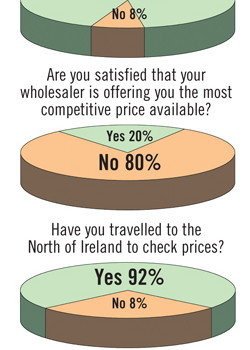ShelfLife Survey: shoppers drive north to save

An exclusive ShelfLife survey of symbol group retailers operating in the border counties has found that a massive 92% of respondents have noticed a downturn in their business.
14 August 2008
It is going to be no surprise to anyone reading these survey results to learn that retailers in the border counties are finding it tough going these days due to the sterling differential that currently allows their customers to shop for less on the northern side of the border. Every newspaper and magazine seems to carry endless column inches extolling the virtues of traveling north to shop. It is ironic that the route to market for these newspapers and magazines are the very shops that the editorial columns are damaging.
80% of retailers who responded to the survey are not satisfied that their wholesaler is offering the most competitive prices available
The national broadcaster, RTE, has been actively encouraging consumers to take shopping trips to the North, while they remunerate the presenters with funds taken from advertisers whose business these shopping trips are undermining. The Irish Government, while being a huge contributor to the cost of doing business in Ireland, is standing squarely behind Eddie Hobbs, Joe Duffy et al when it comes to finger pointing.
The phrase “turkeys voting for Christmas” really does apply.
However, it is the retailers of Ireland that are taking the consumer flak, day in and day out. These are the symbol group owners, their hard working managers and the managers of major multiple branches.
The executives of the various franchise holders or the multiple HQ’s can sit in their offices and bemoan the “crisis” but it is the retailers who are left to face the angry and increasingly hard-pressed consumers of Ireland who are being whipped into a frenzy by media hype about prices and an over-sold recessionary story.
Headed for catastrophe
As this research quite clearly shows, there is huge and mounting pressure on the retailers. It is very encouraging that wholesalers are responding to this burning issue in a number of positive ways, but the question is, just how much can our border retailers take before there is a casualty.
With no sign of an imminent increase in the value of sterling versus the euro, what more can the wholesalers do with their pricing structures to ensure the continuing profitability, or indeed viability, of this particularly vulnerable group.
In fact, our survey shows that 80% of retailers who responded are not satisfied that their wholesaler is offering the most competitive prices available. Furthermore 72% said that they had complained to their symbol group franchise holders about pricing structures.
For years we have been told that consumers are much more vocal when it comes to making complaints. In the ‘good times’, this meant complaints that there wasn’t enough pesto in the “Mediterranean sundried vegetable panini”. In these leaner, meaner times it’s all about price.
What this really means for retailers
To prove this point even further, 84% of retailers who responded to the ShelfLife survey said that customers had complained about the prices they were being charged.
A massive 96% of respondents said that they had been told by customers or were aware that their customers were regularly traveling over the border to shop. And not surprisingly this has resulted in a widespread downturn in business with 92% of respondents claiming this to be the case.
The majority of retailers (72%) who responded to the ShefLife survey have traveled north of the border to check prices for themselves.
Interestingly, what many thought was the main bone of contention between retailers and franchise holders, i.e. the contract agreement that ties the majority of the retailers’ purchases to their wholesaler; did not come in for the bashing that might have been expected.
Indeed over half of border retailers who responded were happy with the flexibility of their contract.



 Print
Print





Fans 0
Followers